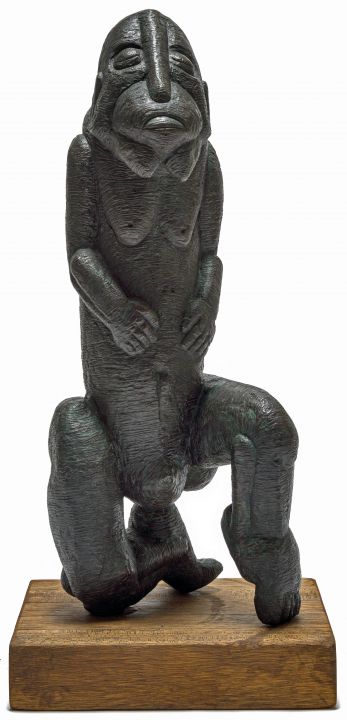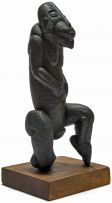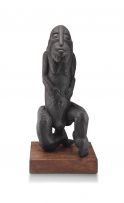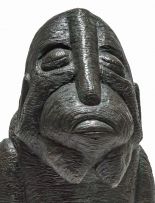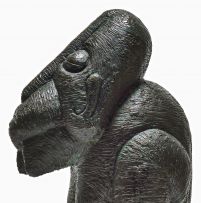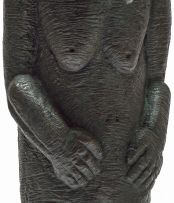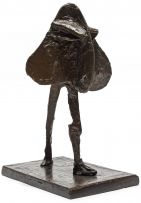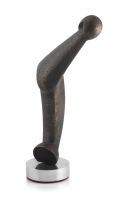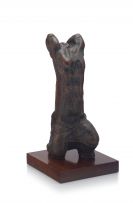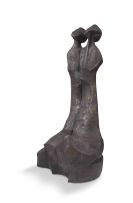Modern, Post-War and Contemporary Art, Decorative Arts, Jewellery and Fine Wine
Live Virtual Auction, 8 - 11 November 2020
Modern, Post-War and Contemporary Art Part II
Incl. Buyer's Premium & VAT
About this Item
signed with the artist's initial and numbered I/X
Notes
Thanks to Dr Gavin Watkins for his assistance in cataloguing this lot.
The group of bronzes that Sydney Kumalo produced in the 1960s, when under the sway of Egon Guenther, is a high-point of South African modernism. Defined by elongated or squat forms, lacerated and hand-rasped surfaces, off-beat cylindrical volumes, poignant simplification, and rich, gorgeous patinas, these works won high acclaim. Powerful, ageless, landmark sculptures - Seated Woman, Killed Horse, St Francis of Assisi, Black Leopard (all 1962), Cock (1963), Portrait of Egon and Beast (both 1965), to name only a few - elevated his reputation, as did ground-breaking shows in Johannesburg and London. With his fellow Amadlozi artists, moreover, he exhibited in Rome, Venice, Florence and Milan in 1962-63, and had work selected for the Venice Biennale in 1966. Critical and commercial success allowed him to vacate his teaching post at the Polly Street Art Centre in 1964 to focus fulltime on his career.
Between 1966 and 1968, riding a peak of creativity, Kumalo became drawn to the motif of the male elder. He developed the theme across twelve small yet monumental works, each as intense, stirring and memorable as the next: this fabled group came to be recognised as the artist's Madala Series (see figures 1-12). The first four of these sculptures, all conceived in 1966, were High Shoulders, Beggar, Tongue Out and Madala I, the present lot, which was also the first to carry the madala appellation. Indebted to traditional African sculpture, and infused with the artist's own cultural loyalties, this madala figure holds an unusual pose: the weight of the body rests on the bent right knee, while the left heel is raised high on stiff toes; the arms are held close to a beautifully pocked and scarified belly; aged breasts droop; the neck is hidden; and the head, oversized and extended, with its long and barrelled nose, its conical chin, its reduced, pursed lips, and its deep-set and gently closed eyes, is angled upwards, as if catching the sun or happily lost in memory.
Under the careful watch of Guenther, Madala I was cast at the Vignali Foundry in Pretoria, and an edition of 10 planned. Only a single casting was produced, however: this unique bronze was shown in 1967 at the 14th annual exhibition of the Transvaal Academy at the Pretoria Art Museum, where it won the Bronze medal. Having remained a treasured part of the late Desmond Fisher collection for decades, the re-appearance of Madala I, a work of such charm, artistry and weight, is of great excitement to academics and collectors alike.
"The sitting or crouching figure is infrequently represented in traditional African sculpture. When it is used the squatting posture is meant to symbolise reverence and devotion. Sydney Kumalo has taken this concept of the seated, devout human being and used it as a vehicle to communicate his own feelings about his experience. [In Madala I ] the old man's weight is supported on his bent right leg and counterbalanced by the rigid left toes, creating a double movement between rest and incipient action. These contradictory rhythms, of two opposing forces held in equilibrium, are characteristic of Kumalo's art as we have seen. Madala's legs form a pedestal which supports the vertical thrust of his body. His arms cleave close to his scarred trunk that rises like a pillar, crowned by his noble head. His spade-bearded face is tilted upwards, eyes closed and cheeks bulging with concentration. The mood is one of intense contemplation. This remarkable image is Sydney Kumalo's accolade to the dignity and to the courage of the old."
Heine Toerien and Georges Duby (eds) (1968) Our Art 3, Pretoria: Foundation for Education, Science and Technology, page 70.
Provenance
The Late Desmond Fisher Collection.
Exhibited
Transvaal Academy, Pretoria Art Museum, 1967.
Literature
Heine Toerien and Georges Duby (eds) (1968) Our Art 3, Pretoria: Foundation for Education, Science and Technology, illustrated on page 72.
Lola Watter (1968) 'Sydney Kumalo: Sculptor', Lantern, Volume XVIII, illustrated on page 42.
